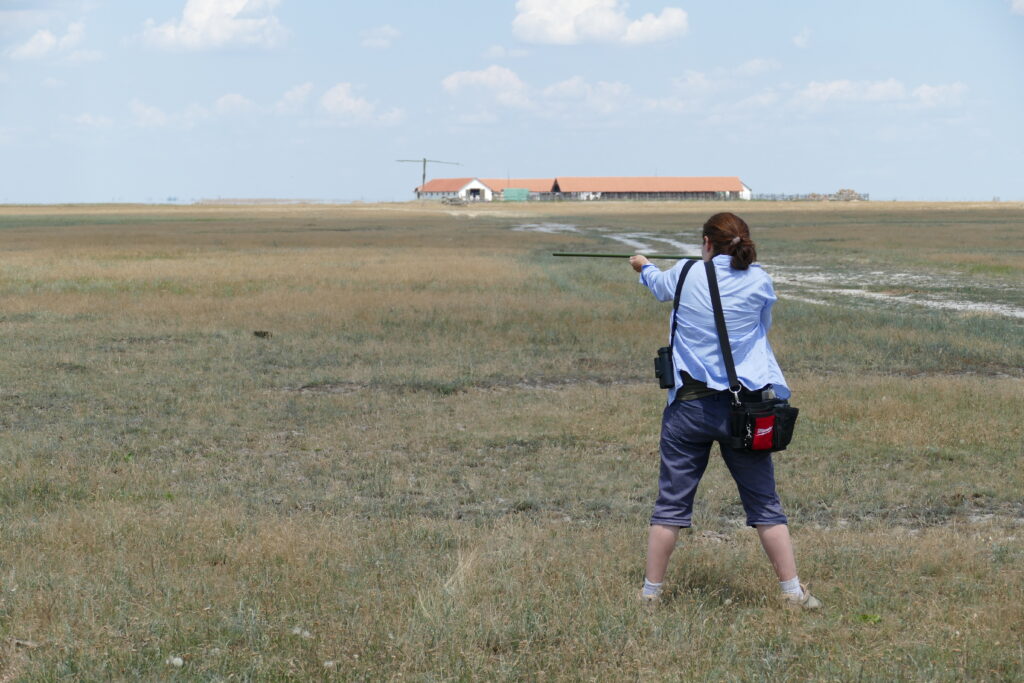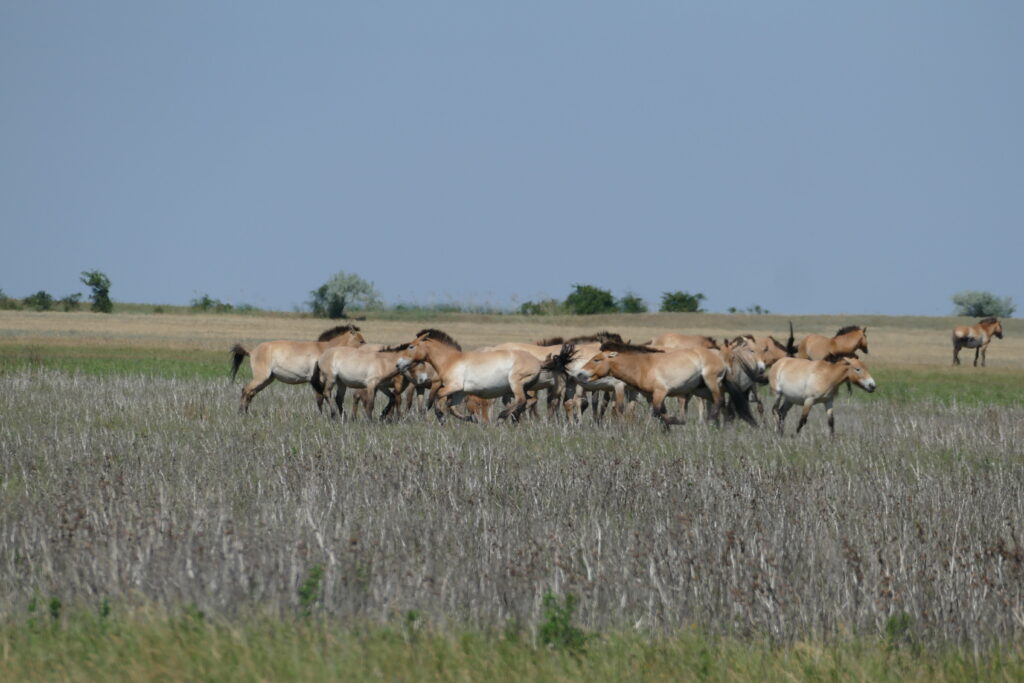In our last article, we told you about what a special place Hortobágyi National Park is. What we left out it is that it is also home to one of the the biggest herds of Przewalski’s horses or takh (the Mongolian name, which we will use) in the world. Because this topic deserves a closer look and because it had a lasting impact on us. We will dive right in to the topic, but if you can learn more about the history of the takh below.

Approaching Hortobágyi National Park, we see mostly grassland and big herds of domestic cattle. Sounds like a common agricultural area that you can find in many places of the world. The difference in the area in and around Hortobágy is that this landscape was not created by clearing forests to create pastures, but that this is the natural landscape. This is unique in Europe and the reason why this part of the Hungarian Puszta was declared a national park. So, when the park was audited by IUCN in the 1990s, they agreed that the reintroduction of wild large herbivores would contribute to restoring natural conditions in the area. This was a few decades after the takh had died out in the wild and breeding programs were looking for sites to release them into (semi-) wild conditions. This is the reason that 300 takh live in Hortobágyi National Park nowadays.

The only wild takh in Europe
To learn more about them and the project, we meet Viola Kerekes, the leader of the takh project, and Tímea Szabados, the project assistant. They take us to the Pentezug reserve, a 3000 ha large strict protection zone of the national park that is fenced and not open for visitors. For quite a while, after crossing the entrance, we see not much besides dry grassland. But after a while, brown and black spots appear on the horizon. These are the takh and the Taurus cattle, a specific breed of cattle that is bred to resemble the extinct aurochs. When we arrive, we are surrounded by 300 horses that look similar to domestic horses, but have the distinct features of takh: a standing mane, a rather small and muscular body, light to dark brown color and stripes on their legs.

Viola and Tímea are coming out to do an important job today: to vaccinate some mares with a contraceptive. Since the first release in 1997, the takh have reproduced so well that the population has reached their maximum number. The reserve is limited to 3000 ha, which means that it cannot support more than 300 takh, especially because they share it with around 250 taurus cattle.

How to know 300 horses by name
From the first moment, we feel that Viola loves the horses and has incredible expertise. She tells us that every horse has a name depending on their year of birth and lineage. We wonder how they tell them apart and Viola shows us. Takhs live in small harem groups of 2 up to roughly 20 animals. So, to identify an individual, they look for the group, which always stays close together. Most groups have at least one individual that is easy to identify and starting from that one, there are tiny features that make is possible to identify each member of the group. This can be spot on the fur, a chip in the ear or a bump on the foot. Viola and Tímea talk to each other to identify the individuals they need to find today, and we hear names like “Bornemissza” and “Vicus” based on the characters of a famous Hungarian novel, as well as “Nutella”, whose family line is all named based on desserts. You can imagine how hard it must be to remember the names of 300 people from your family tree, and those are just the names. Connecting these names to the individuals based on small features is really next level. Our biking helmets down to Viola and Tímea!
A window into the past
But even though we don´t know each one by name, we are intrigued by them from the first moment. At first it might seem like they are not doing much besides eating, but there is constant interaction, movement and change. Stallions fight for dominance, mother take care of their foals, they go drinking at the river unanimously, single groups or individuals break of the group and join it again. Viola and Tímea tell us (half-joking) that is seem like the takh know what they are here for and always protect the mares they are looking for. Watching the herd out here in the steppe is a window back in time thousands of years ago, when horses shared this space with wild ass, aurochs, wolves, bears and lions, which all disappeared here. They still search for safety, sticking together in a big group, although there are no predators that try to hunt them down.
The central role of Hortobágy
The Hortobágy herd is central for takh conservation around the world being one of the biggest populations in the world. Much research has taken place here and it is an important part of the worldwide breeding programme. We have the feeling that Viola does not only know all these horses by name, but also everyone who works with takh anywhere in the world. After their extinction in the wild 50 years ago, there are now several herds living in (semi-) wild conditions. So, we wonder why they have to give contraceptives to the animals here and cannot bring the foals to other release sites or zoos. Viola answers that she would love to and there is well coordinated network exchanging individuals, but there is no space in captivity and it is complicated and expensive to transport them thousands of kilometers. Reintroduction sites are rare because it is hard to find places where the wild horses do not compete with livestock. Reintroduction efforts are very sensitive and released horses have to be chosen well and monitored, for example to avoid interbreeding with domestic horses. All of this is coordinated by an international endangered species coordinator, who is responsible for coordinating any decision affecting the species, including suitable sites and their management.
Nevertheless, the worldwide takh population is continuously rising and reintroduction is slow, but successful. Hopefully, there will soon be more places like Hortobagy, where you can see these graceful animals in the wild in large numbers. After spending a whole morning with the horses, Viola and Tímea, we probably have a sunstroke – it was very hot and takh avoid shade to escape the flies – but mainly, we learned an incredible amount about takh, we got an insight in their intrigue social structures, as well as Viola´s and Tímea´s work.
The Pentezug reserve is closed for visitation, however, a smaller population of taurus cattle and takhs can be visited in the Hortobágy Wild Animal Park.



The history of Przewalski’s horses
Horses are very versatile animals. We ride on them – to get somewhere, to have fun and to compete in show jumping, dressage or vaulting –, they pull carriages, plough the fields or we just hold them as pets to enjoy their grace. They were crucial in developing civilizations over millennia, are still used as utility animals around the world and even where this use declines, they are deeply rooted in culture and beloved. So, naturally most people only know them as utility animals, livestock and pets. What people easily forget is that, like all animals, our domestic horses are descendants of wild horses.
There is a good reason for that. The closest truly wild relative of domestic horses that still occurs in large numbers in the wild is the zebra. But it was not always like this. Long before humans populated this planet, big herds of wild horses roamed most parts of the worlds, from North- to South-America and to China. Some of them were quite different from our modern horses and several species went extinct over the millennia. But in Europe and Central Asia, wild horse species survived not so long ago. Unfortunately, they eventually had the same faith that most large herbivores suffered. The spread of human settlements, agricultural fields and livestock took away their space to live. After domesticating horses (and cows, sheep, goats) roughly 5000 years ago, their wild relatives turned into competition for humans. Hence, they were shut out from grazing grounds with fences or simply killed. The last truly wild horse, which means its ancestors were never kept in captivity, died in the 1960s.
Excursion: Some clarification might be necessary here. Hundreds of thousands of horses live in the wild in many places in the world. The most known are probably the mustangs in the US and the currently biggest population in Australia of ca. 400,000 so-called brumbies. However, they are not considered truly wild horses because they are descendants of domestic horses (Equus ferus caballus) that have evolved in human captivity for thousands of years. Przewalski's horses (Equus ferus przewalskii) are considered the only living (sub-) species of wild horses, because they have been living in the wild away from humans until the 1960s, when all populations in the wild vanished. Many other species of horses have existed through the last million years, but all others went extinct.
They disappeared from the wild…
These last true wild horses that survived in the wild were the so-called Przewalski’s horses or takh. They are the closest relative of domestic horses and lived in steppes and semi-deserts in Central Asia. We know them by the name Przewalski’s horses because a Russian-Polish naturalist defined the species in 1881. They were more or less unknown until that time and by that time, they could only be found in remote corners of the Mongolian deserts. All other wild horses were extinct; therefore, this discovery created many desires to own some of the last wild horses in the world. Many important figures like Carl Hagenbeck sent expeditions to capture some individuals to bring them to Europe. But these expeditions were not prepared that takh are much stronger, wilder and harder to catch as well as handle than domestic horses. Hence, many horses died during the capture, transport or in zoos. The desire to own the last wild horses in combination with continuous habitat loss drove the last wild populations to extinction. Between 1903 and 1947, no individuals were sighted at all and after a few sightings in the 50s and 60s, the last stallion was reported in 1969.
… but more and more were born in captivity.
The only upside to the deep wish of Europeans, Americans and Australians to own these rare animals was that twelve individuals survived and reproduced in captivity by 1960. And while the wild population in Mongolia was slowly dying out, zoos in Europe and America put a lot of effort into breeding horses. This was not easy with 12 animals remaining and resulting inbreeding, but due to international coordination, cooperation and exchange, the population could be increased to 1500 until the 1990s and to 2200 up to now.









